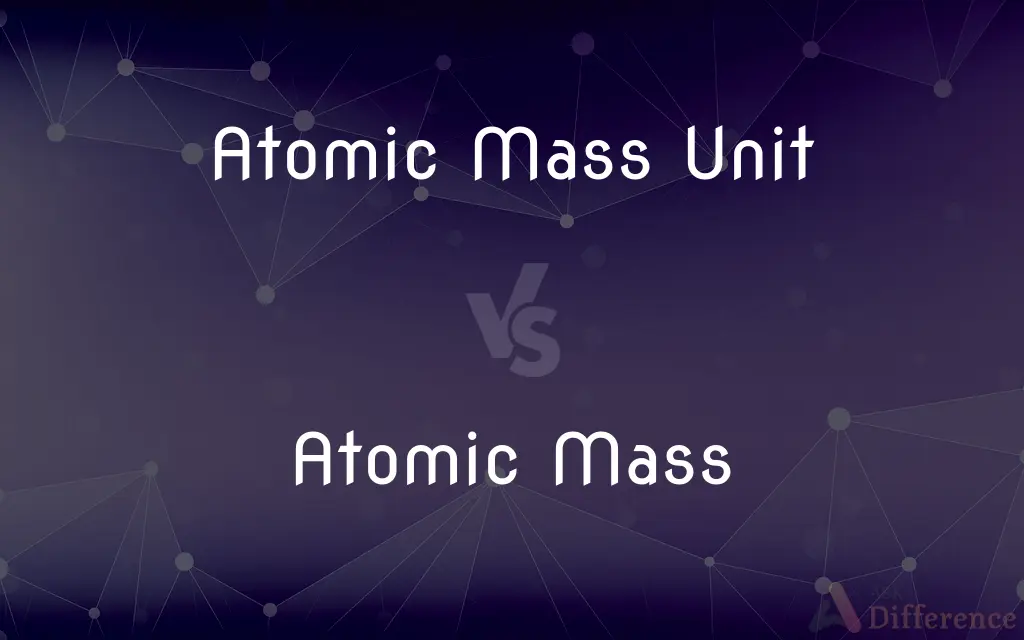Atomic Mass Unit vs. Atomic Mass — What's the Difference?
By Tayyaba Rehman — Published on November 27, 2023
The atomic mass unit (AMU) is a standard unit of mass for atomic and molecular weights. Atomic mass refers to the weighted average mass of an element's isotopes. They differ in concept: one is a unit of measure, the other a property of elements.

Difference Between Atomic Mass Unit and Atomic Mass
Table of Contents
ADVERTISEMENT
Key Differences
Nature and Concept: The atomic mass unit (AMU) serves as a standardized unit of mass for expressing atomic and molecular weights. In contrast, the atomic mass of an element provides the weighted average mass of its isotopes relative to the AMU, reflecting the natural isotopic composition.
Representation: In scientific literature, the atomic mass unit is typically represented with the symbol "u" or "amu". Atomic mass, on the other hand, is a specific value associated with each element and can be found on the periodic table, represented usually in atomic mass units.
Relevance: Atomic mass unit is crucial in ensuring consistency across scientific disciplines when expressing minuscule weights on the atomic or molecular level. Atomic mass helps in understanding the natural isotope composition of elements and offers insight into the relative abundance of those isotopes.
Application: Scientists often use the atomic mass unit when discussing the mass of specific atoms or molecules. Atomic mass, meanwhile, proves useful in chemistry, especially when determining the amount of an element in a given sample using stoichiometry.
Isotopic Variation: The atomic mass unit remains consistent across all elements and molecules. However, atomic mass can vary slightly between different samples of the same element due to the variance in isotopic abundance.
ADVERTISEMENT
Comparison Chart
Nature/Concept
Standard unit of mass
Weighted average mass of isotopes
Representation
Often denoted as "u" or "amu"
Specific value for each element on the periodic table
Relevance
Standardizes atomic/molecular weights
Indicates natural isotope composition
Application
Used to express individual atomic/molecular masses
Used in stoichiometry and chemistry
Variability
Consistent across all elements
Varies with isotopic abundance
Compare with Definitions
Atomic Mass Unit
Represents one twelfth the mass of a carbon-12 atom.
The atomic mass unit is based on the carbon-12 isotope.
Atomic Mass
Expressed relative to atomic mass units.
Carbon has an atomic mass close to 12.
Atomic Mass Unit
A standard unit for atomic and molecular weights.
Hydrogen has a mass close to 1 atomic mass unit.
Atomic Mass
Varies due to natural isotopic abundances.
The atomic mass of boron can differ slightly based on its source.
Atomic Mass Unit
Often symbolized as "u" or "amu".
The molecule had a mass of 30 amu.
Atomic Mass
A property found on the periodic table.
You can find the atomic mass of helium on the periodic table.
Atomic Mass Unit
Used to express extremely small masses.
Electrons have a mass much less than one atomic mass unit.
Atomic Mass
Weighted average of the isotopes of an element.
The atomic mass of chlorine is about 35.5.
Atomic Mass Unit
Ensures consistency in scientific measurements.
Using the atomic mass unit standardizes mass values across research studies.
Atomic Mass
Crucial for stoichiometric calculations in chemistry.
Knowing the atomic mass helps chemists balance equations.
Common Curiosities
How is the atomic mass different from the atomic number?
Atomic mass represents the average weight of isotopes, while atomic number indicates the number of protons.
Why is carbon-12 used as the reference for atomic mass unit?
Carbon-12 offers a stable reference, and its mass defines the atomic mass unit.
Is the atomic mass constant for an element?
No, atomic mass can vary slightly based on the natural isotopic abundance of the element.
What is the main purpose of the atomic mass unit?
The atomic mass unit provides a standardized measurement for atomic and molecular weights.
Is the atomic mass unit related to grams?
Yes, one mole of atomic mass units is equivalent to one gram.
How do isotopes affect atomic mass?
Isotopes have different masses, so their relative abundance influences the weighted atomic mass.
Why is atomic mass not a whole number?
Atomic mass is an average of isotopic masses, leading to non-whole number values.
How do I convert from atomic mass to grams?
Use Avogadro's number and the molar mass of the element.
How accurate is the atomic mass on the periodic table?
It's a weighted average, so it's accurate for typical terrestrial samples.
What's the relationship between atomic mass and atomic mass unit?
Atomic mass is the average isotopic weight of an element expressed in atomic mass units.
Can two elements have the same atomic mass?
While uncommon, two elements can have very close atomic masses due to rounding.
Why do some elements have atomic mass in parentheses?
Parentheses indicate an element's atomic mass is based on a specific isotope due to rarity or instability.
Is atomic mass affected by external factors?
No, atomic mass is intrinsic to the element and its isotopes.
Why is understanding atomic mass essential?
It aids in various calculations, from molecular weight to stoichiometric conversions.
What's the significance of atomic mass in chemistry?
Atomic mass aids in stoichiometric calculations, helping balance reactions.
Share Your Discovery

Previous Comparison
Longitudinal Section vs. Transverse Section
Next Comparison
Brown Sugar vs. White SugarAuthor Spotlight
Written by
Tayyaba RehmanTayyaba Rehman is a distinguished writer, currently serving as a primary contributor to askdifference.com. As a researcher in semantics and etymology, Tayyaba's passion for the complexity of languages and their distinctions has found a perfect home on the platform. Tayyaba delves into the intricacies of language, distinguishing between commonly confused words and phrases, thereby providing clarity for readers worldwide.
















































